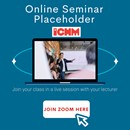Welcome to Topic 7: Managing Performance and Building Capability. It is always important to ensure that employee performance is managed to maintain employee turnover. We will look at ways to improve the performance of the employees. We will look at various teams and groups that are seen in present-day organisations.
In this topic you will learn about:
- Managing groups and teams
- Groups and teams
- Types and characteristics of teams.
These relate to the Subject Learning Outcomes:
- Assess the key principles and theories underlying strategic people management and explain how their application enhances organisational and individual performance.
- Evaluate the effectiveness of different approaches of leadership and the relationships between effective people management and organisational performance.
- Reflect on the roles and functions that managers perform in the context of the challenges and risks they experience in the changing environment.
Welcome to your pre-seminar learning tasks for this week. Please ensure you complete these prior to attending your scheduled seminar with your lecturer.
Click on each of the following headings to read more about what is required for each of your pre-seminar learning tasks.
Read the following pages (pp. 30-31; 86-87; 609-611) of the prescribed text – University of Minnesota 2015, Principles of management, University of Minnesota Libraries Publishing edition.
Read the following web articles:
- Brandon, J 2011, What is the true meaning of success, Inc Magazine.
- Economy, P 2017, Want Your Next Week to Be Super Productive? Try These 5 Success Strategies, Inc Magazine.
- Employsure n.d., Managing Employee Performance, Employsure Pty Ltd.
Complete the Topic 7 worksheet 1 and save a copy to your reflective journal.You can access the reflective journal by clicking on ‘Journal’ in the navigation bar for this subject.
Read and watch the following content.

Managing performance and building capability
If someone asked you what you admire about an organisation like Amazon, Microsoft, or Apple, you might say that you respect their ability to innovate. For example, how the organisations respond to customer needs and their advancement in thinking. This can come down to organisational capabilities. Building capability goes beyond training staff, it is about transforming an organisation’s culture to focus on the role management plays in attracting and retaining talent. This topic builds upon the previous topic, where we looked at performance and talent. So, what does it mean to build capability? It means to provide your team with new skills that will support the organisation (Smallwood & Ulrich 2004). We might see this in the form of professional development training, such as doing a course in team building. It is not just about upskilling employees but about creating a strong and reliable skillset that builds the organisations capability.
Let us look at why organisational capabilities are important. There are three (3) key reasons, including:
- Gains a competitive advantage
- Helps to adapt to change
- Drives business performance.
Learning task: organisational capabilities
Read the following article:
Boatman, A n.d., Organizational capabilities: definition, examples, and building process, AIHR.
Take notes in your reflective journal.
Next, we will look at performance management. We touched on this briefly in the previous topic, but will expand you understanding here.
What is performance management?
Performance management is often described as management ensuring that employee activities and outputs are compatible with the organisational goals. Schermerhorn (2004, p. 335) defines it as “sets standards, assesses results and plans for performance improvements”.
For many organisations today, to prosper or survive, it is essential to seek ways to improve performance constantly. Walker and Miller (2010) argue that there are five major reasons for high turnover and low productivity; Employees don’t know what they are meant to be doing. They don’t know how they are meant to be doing it. They don’t know how well they are doing it. The manager/supervisor has not given them any direction. They have a poor relationship with the manager/supervisor.
Performance management systems must include the following three (3) aspects:
- Define performance.
- Measure performance.
- Feedback performance information.
A good performance management system should begin with job analysis and job descriptions.
After this, the first step is to define the purpose for which performance standards will be used. This should define a day’s work, set standards, develop training programs, and evaluate the job performance.
Three (3) essentials for success:
- Worker participation: leads to better results, commitment, and morale (also ensure use full capabilities of each employee)
- Active supervisory leadership throughout: be in charge at all times, but work together
- Built in reward system: rewards linked to how well each worker or team meets the performance standards.
KPIs and core competencies
Let’s now look at the ways to measure performance, and these are referred to as key performance indicators (KPIs). They can be used to assess success of particular activities that an organisation is involved in. For example, a KPI for a retail store may be 90% customer satisfaction or 10% increase in sales. Choosing the right KPIs depends on what is important to each individual organisation and/or industry sector. For some industries such as retail, KPI’s may vary between departments. These assessments often lead to identification of improvements required and can thus be incorporated into the cycle of goal setting (Davidson et al. 2009). A widely used method of choosing KPIs is to apply the balanced scorecard approach.
The balanced scorecard (BS) is an attempt to combine a range of qualitative and quantitative indicators of performance which recognise the expectations of various stakeholders (owners, managers, employees, customers) and relates performance to choice and decisions made in strategy and goal setting (Mullins 2016).
Learning task: reflection
When we performance manage retail employees, there are a multitude of various positions, some dealing directly with customers and others that complete tasks that affect customer satisfaction.
What techniques/methods and measures could be considered in measuring performance in the retail industry?
Write your response in your reflective journal.
Management by objectives (MBO) is a technique for managing performance that emerged in the 1950s, where many of the ideas and rationales are still relevant to performance management today. MBO is a goal-directed activity that relies upon setting clear targets for each employee and reviewing the individual's performance against those targets. Here, the targets are set in conjunction and discussion with employees. The idea is that employee participation in setting goals and objectives increases employee commitment to achieving targets. The negative with MBOs and other goal-setting activities is that objectives or goals may not be achieved because of reasons beyond the employee’s control.
Total quality management (TQM) is a system of performance management. The goal is to ensure continuous quality improvement of services and products for guests. TQM is applied in all areas of business and at every level. It consists of 10 steps:
- Have excellent leaders as supervisors and managers.
- Build and train teams of employees within each department and later cross-departmentally in problem-solving.
- Teams decide on, and write down the appropriate levels of guest service and relative weighting for ‘their guests’.
- Set mission, goals, and strategies based on guest expectations.
- Empower and inspire employees to reach goals.
- Identify deficiencies, which are areas where service falls below expectations.
- Analyse and resolve identified deficiencies.
- Modify processes to incorporate corrections to improve service to expected levels.
- Track results – improvements in service, guest satisfaction, employee satisfaction, cost reduction, and profit.
- Evaluate and support the process.
Purpose of performance appraisal interviews and feedback
A crucial aspect of appraisal is the conduct of the interview itself. The purpose of such appraisal may include:
- To evaluate and give recognition
- To document performance
- To let employees know how they are going
- To set work improvement goals
- As a basis for salary increases/review
- To identify employees for potential advancement
- To possibly be used by other managers (in employee promotion, job rotation)/
- To rate own performance (in hiring, training)
- It provides an occasion to get feedback from employees.
The approach to appraisals and appraisal forms
There are many different ways to approach appraisal and develop appraisal forms for employees. The forms or schemes can be divided and concerned mainly with the following:
- ‘Outputs’ (results-oriented)
- ‘Inputs’ (job behaviour or personality traits oriented)
- A combination of the two.
Learning task: research
Conduct a Google search on different appraisals and appraisal forms. You can use the three schemes to assist you.
Identify three (3) key takeouts from your research.
Write your responses in your reflective journal.
Training and development
What do you think training and development is?
Learning task: keywords
In your reflective journal, write down five (5) words that come to mind when you think of training and development is?
What did you come up with? Were any of these key terms on your list?
- Skills
- Knowledge
- Decision making
- Team work
- Language
- Diversity.
One major area of the human resource function of particular importance to the effective management and use of people is training and development. While training and development are essential to building capacity, it is not the only focus. Remember earlier in the topic we identified that building capacity is about transforming an organisation’s culture to focus on the role management plays in achieving organisational goals through training, attracting employees and succession planning.
Recent years have seen training teams renamed 'training and development' or 'learning and development'. Mullins (2016) states that there are some fundamental differences between these terms:
- Training is a content-based activity, often away from the workplace with an instructor leading and aiming to change individual behaviour and attitudes.
- Learning is a self-managed process of acquiring new knowledge and the skills with the aim of increasing performance.
- Development is wider than both training and learning and is a longer term, structured learning process including a number of activities, including training.
- Developing human resources is essential because:
- High quality = competitive advantage
- Achieved through effective utilisation of human resources
The purpose of training is to improve knowledge and skills and to change attitudes. It is one of the most important potential motivators. This can lead to the following benefits for employees and the organisation:
- Increase the confidence, motivation and commitment of employees
- Provide recognition, enhanced responsibility as well as the possibility of pay increases and promotion
- Instill a feeling of personal satisfaction and achievement, as well as broaden the opportunities for career advancement
- Help increase the availability, quality and skills of staff (Mullins 2016).
To succeed in training of employees there must be a clear commitment to training throughout all levels of the organisation. Managers must be committed to the program and philosophy of improving the skills and attitudes of employees, and give this opportunity to all (equity in opportunity). Training needs analysis should be an on-going process, linked to goal setting, measurement and improvement. Employees should also feel part of this process, not only in opportunities given for training, but also in the development of training programs. At the completion of training programs evaluation should be related to objective and measurable factors (Mullins 2016).
Training aims to improve current or future management performance by imparting knowledge, changing attitudes, or increasing skills. Now you should have a basic understanding of what it means for organisations to build capability and performance management and training ties into it.
Knowledge check
Complete the following two (2) tasks. Click the arrows to navigate between the tasks.
Key takeouts
Congratulations, we made it to the end of the seventh topic! Some key takeouts from Topic 7:
- Importance of managing employee performances.
- Recognise and understand group dynamics and development.
- Understand the difference between groups and teams.
Welcome to your seminar for this topic. Your lecturer will start a video stream during your scheduled class time. You can access your scheduled class by clicking on ‘Live Sessions’ found within your navigation bar and locating the relevant day/class or by clicking on the following link and then clicking 'Join' to enter the class.
Click here to access your seminar.
The learning tasks are listed below. These will be completed during the seminar with your lecturer. Should you be unable to attend, you will be able to watch the recording, which can be found via the following link or by navigating to the class through ‘Live Sessions’ via your navigation bar.
Click here to access the recording. (Please note: this will be available shortly after the live session has ended.)

In-seminar learning tasks
The in-seminar learning tasks identified below will be completed during the scheduled seminar. Your lecturer will guide you through these tasks. Click on each of the following headings to read more about the requirements for each of your in-seminar learning tasks.
Work in a breakout room assigned by your lecturer during the scheduled seminar. Your lecturer will request that you present the findings back to the class.
Select two organisations that are distinctly different from each other such as one has a core product as a tangible good (Ikea) and one that has a core product as a service (Jim’s Dog Wash).
Complete the following questions:
- In a comparison table, identify how you would train the staff? Would the training be different depending on the country the store is in?
- Is talent management important in these organisations? If so why? If not why not?
- How would you manage the performance of employees in both these organisations? Are there any similarities or differences?
Welcome to your post-seminar learning tasks for this week. Please ensure you complete these after attending your scheduled seminar with your lecturer. Your lecturer will advise you if any of these are to be completed during your consultation session.
Complete this task during the consultation session.
In your reflective journal, respond to the following questions:
- What are your critical takeaways about Performance Management Systems?
- How can organisations ensure that goal-setting statements, measurement, tools, approaches and appraisals are used effectively in management?
- In what ways can a manager ensure that feedback is provided to promote employee participation and continuous improvement?
Ensure your case study analysis is ready to submit. This is your final opportunity to proofread your work and finalise your group work documentation.
Each week you will have a consultation session, which will be facilitated by your lecturer. You can join in and work with your peers on activities relating to this subject. These session times and activities will be communicated to you by your lecturer each week. Your lecturer will start a video stream during your scheduled class time. You can access your scheduled class by clicking on ‘Live Sessions’ found within your navigation bar and locating the relevant day/class or by clicking on the following link and then clicking 'Join' to enter the class.
Click here to access your consultation session.
Should you be unable to attend, you will be able to watch the recording, which can be found via the following link or by navigating to the class through ‘Live Sessions’ via your navigation bar.
Click here to access the recording. (Please note: this will be available shortly after the live session has ended.)

- Hagel, J, Wooll, M & Brown, JS 2020, Human inside: How capabilities can unleash business performance, Deloitte.
- Rungi, M 2014, ‘The impact of capabilities on performance’, Industrial management & data systems, 114(2):241-257
- Smith, J 2021, Building performance and capability, The HR Director.
References
- Davidson, P, Simon, A, Woods P & Griffin RW 2009, Management: Core concepts and applications, 2nd edn., John Wiley.
- Gordon, J 1992, 'Work teams: How far have they come?', Training, 29:59-65.
- Dunnette, MD 1976, Handbook of industrial and organizational psychology, Rand McNally College Pub. Co.
- McGrath, JE 1984, Groups: Interaction and performance, Prentice Hall.
- Mullins, L 2016, Management and organisational behaviour, 11th edn., Pearson.
- Smallwood, N & Ulrich, D 2004, Capitalizing on capabilities, Harvard Business Review, https://hbr.org/2004/06/capitalizing-on-capabilities
- University of Minnesota, 2015, Principles of management, University of Minnesota Libraries Publishing Edition.

